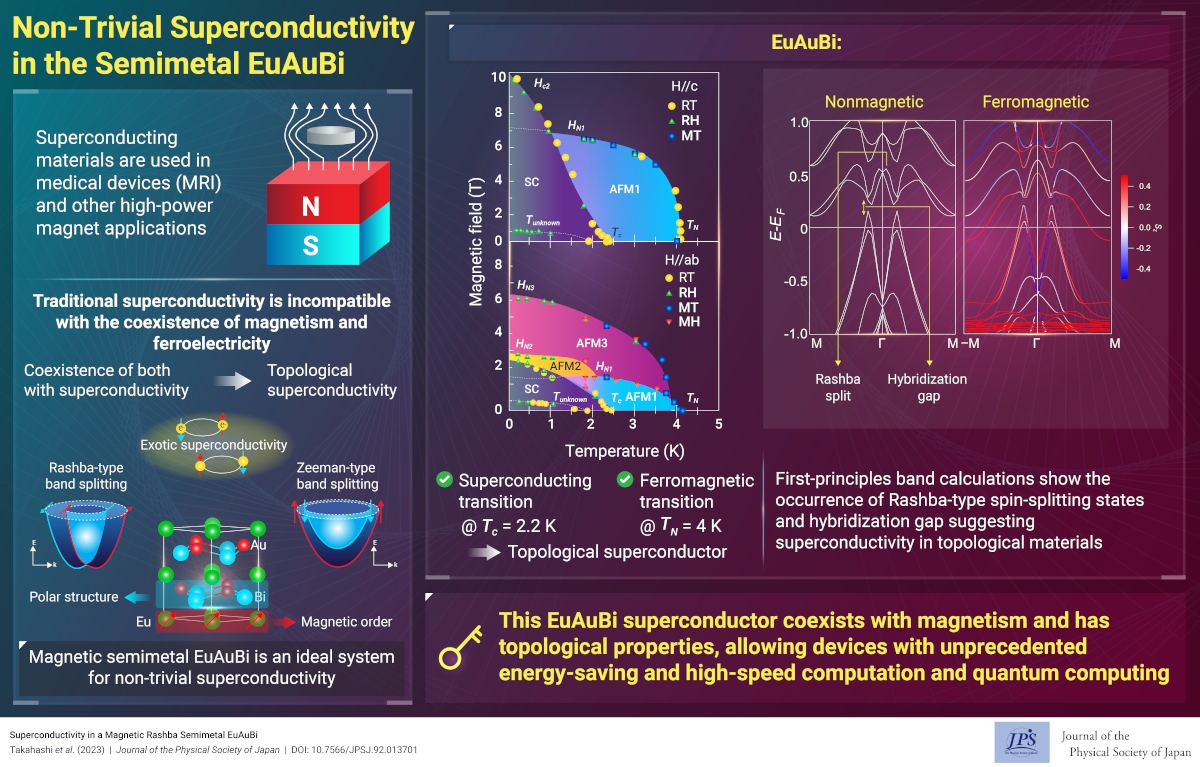Non-Trivial Superconductivity in the Semimetal EuAuBi
© The Physical Society of Japan
This article is on
Superconductivity in a Magnetic Rashba Semimetal EuAuBi
(JPSJ Editors' Choice)
J. Phys. Soc. Jpn. 92, 013701 (2023).
Magnetic order and superconductivity coexist in a noncentrosymmetric topological semimetal, EuAuBi. EuAuBi exhibits a large, anisotropic critical field with Rashba spin–orbit coupling, which can help develop superconducting spintronic materials.

In conventional s-wave superconductivity described by the Bardeen–Cooper–Schrieffer (BCS) theory, superconducting Cooper pairs are mediated by phonons, and these pairs (spin singlet) exhibit time-reversal and space-inversion symmetries. Therefore, magnetism and polarity that break these symmetries are generally incompatible with s-wave superconductivity. By contrast, superconductivity in systems without time-reversal and space-inversion symmetry has recently attracted attention as unconventional superconductivity. In particular, systems without space inversion symmetry exhibit a mixture of singlet and triplet pairing states. Furthermore, topological materials with surface states demonstrate spatial inversion symmetry breaking at the crystal interface, thereby providing a possibility for developing materials with unusual surface superconductivity.
In this study, we successfully synthesized a single crystal of the topological semimetal EuAuBi, which has a layered structure comprising magnetic Eu triangle and conducting Au-Bi honeycomb layers. The synthesized crystal demonstrated antiferromagnetic and superconducting transitions at 4 and 2.4 K, respectively. The polar structure of this material is responsible for the alternating displacement of Au and Bi ions, resulting in a unique system that exhibits magnetic ordering and superconductivity with a polar structure.
To investigate the superconducting properties of this material, changes in the superconducting transition temperature were measured down to as low as 0.1 K by applying an in-plane and an inter-plane magnetic field. Consequently, a superconducting critical field of 10 T, considerably greater than the Pauli limit expected for conventional superconductivity, was observed in the inter-plane field, while the critical field was only 3 T in the in-plane field. First-principles calculations revealed that Rashba spin splitting and a topological band structure are realized owing to the polar structure and strong spin–orbit coupling of Bi p orbitals. Therefore, the large critical field above the Pauli limit and its anisotropy may reflect a Rashba-type band structure and surface superconductivity, suggesting the realization of unconventional superconductivity.
For the first time, we unveiled superconducting properties in the topological semimetal EuAuBi, which exhibits magnetic order and polar structure. The coexistence of large magnetization and superconductivity in this system may accelerate the development of spintronic materials that exhibit a novel external field response.
(written by H. Takahashi on behalf of all the authors. )
Superconductivity in a Magnetic Rashba Semimetal EuAuBi
(JPSJ Editors' Choice)
J. Phys. Soc. Jpn. 92, 013701 (2023).
Share this topic
Fields
Related Articles
-
Electricity Provides Cooling
Magnetic properties in condensed matter
Structure and mechanical and thermal properties in condensed matter
Cross-disciplinary physics and related areas of science and technology
2024-10-15
Electric cooling at low temperatures is successfully achieved using a ferroelectric ferromagnetic solid instead of refrigerant gases such as fluorocarbons.
-
Pressure-Tuned Classical–Quantum Crossover in Magnetic Field-Induced Quantum Phase Transitions of a Triangular-Lattice Antiferromagnet
Magnetic properties in condensed matter
Electron states in condensed matter
Cross-disciplinary physics and related areas of science and technology
2024-9-5
The correspondence principle states that as quantum numbers approach infinity, the nature of a system described by quantum mechanics should match that described by classical mechanics. Quantum phenomena, such as quantum superposition and quantum correlation, generally become unobservable when a system approaches this regime. Conversely, as quantum numbers decrease, classical descriptions give way to observable quantum effects. The external approach to classical–quantum crossover has attracted research interest. This study aims to demonstrate a method for achieving such control in materials.
-
The Mysterious Superconductivity of Sr2RuO4
Superconductivity
2024-8-22
Researchers review the recent advancements made towards solving the mysteries of the unconventional superconductivity of Sr2RuO4, analyzing recent experiments and theoretical models and proposing approaches to resolve current challenges.
-
Discovery of Unconventional Pressure-Induced Superconductivity in CrAs
Superconductivity
Electronic transport in condensed matter
2024-8-13
A new study has discovered pressure-induced superconductivity in the helimagnet CrAs, originating in the vicinity of the helimagnetic ordering, representing the first example of superconductivity in Cr-based magnetic systems.
-
Unification of Spin Helicity in the Magnetic Skyrmion Lattice of EuNiGe3
Magnetic properties in condensed matter
2024-8-7
In the magnetic skyrmion lattice of non-centrosymmetric EuNiGe3, the original magnetic helicity, determined by the antisymmetric exchange interaction, is reversed, resulting in a unified helicity.
